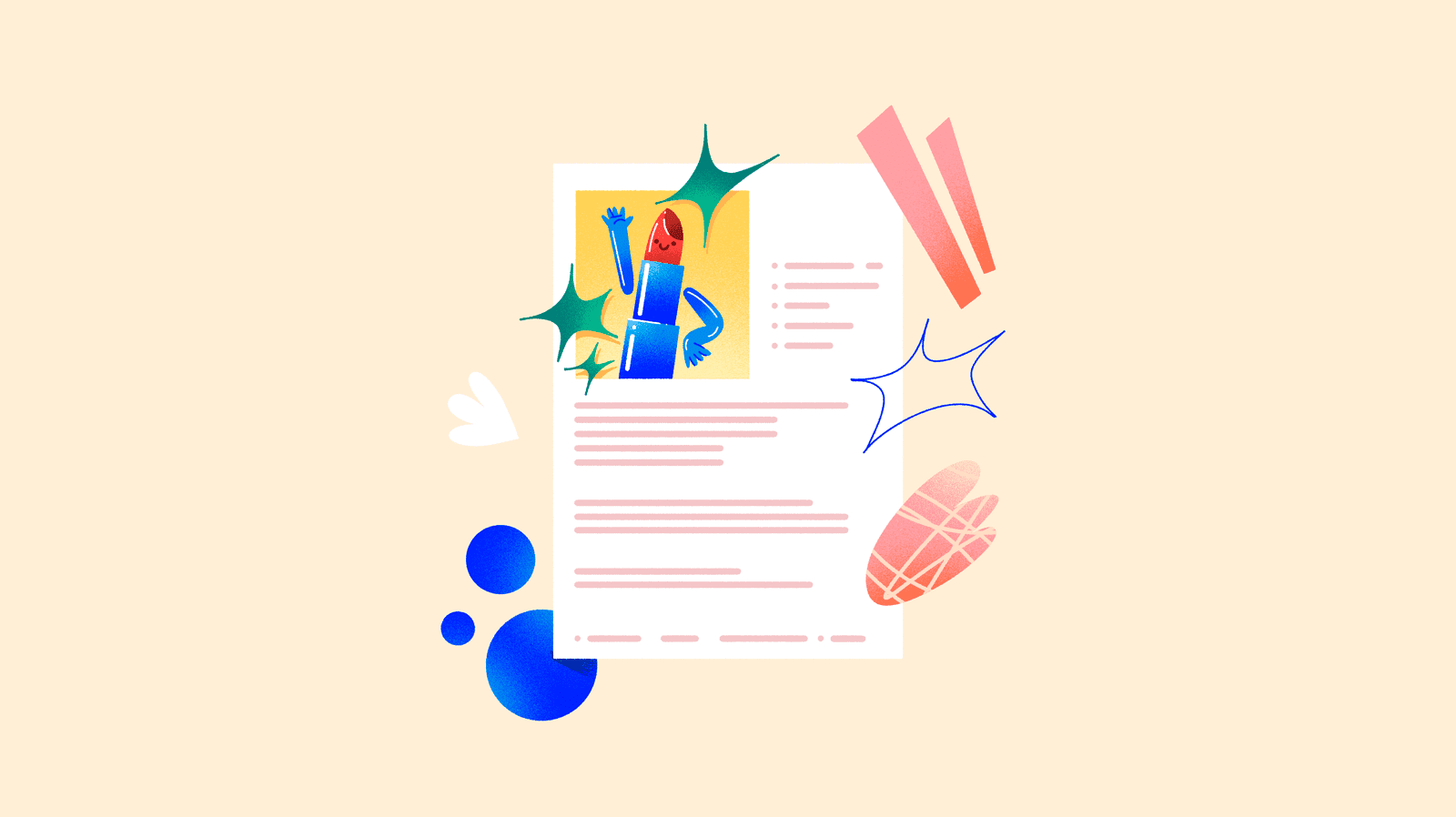
Your cosmetics marketing plan for 2021
In recent years, the Asian market’s growing interest in cosmetics and foreign brands has made beauty and wellness one of the most promising markets today.
And the western consumer has responded with the same interest towards Asian cosmetics. Not to mention that the conditions of the last year have increased the value of the cosmetics sector for many people – who are now more concerned with personal care and use these types of products as a type of home therapy.
Just like Italian pasta, everyone likes to look good, and cosmetics are a global export. But positioning cosmetics products across the world and before increasingly interested customers requires careful revision of your use of language and your catalog content.
Tips for your cosmetic product content
An attractive and fun message
Brand loyalty for these types of products is very high, as consumers prefer to find the perfect formula rather than continually trying new products.
Cosmetics consumers prefer brands that offer an original and innovative approach, along with an attractive and well-designed digital shopping experience.
Matching the cosmetics to their needs is essential, but it is also very important that consumers feel connected to your message and believe that the information provided is comprehensive and fresh.
A clear and honest business philosophy
More and more cosmetics consumers are choosing products that have not been tested on animals, or natural products offering alleged health benefits, and are willing to pay more for products in this category.
As such, the most important element in the sale of cosmetics products is not price, but the message and philosophy conveyed to the public through your marketing and catalog content.
If you sell this type of cosmetics, make your range stand out and encourage related searches by using suitable tags and keywords: vegan, vegetarian, cruelty-free, organic, etc.
However, if you don’t market this type of product, you can still reach a large audience. Regardless, although the ingredients used in cosmetics are tested and not truly harmful, it’s always important to indicate which are included on your product pages.
Knowing that a shampoo contains sulfates may convince an indecisive customer, rather than leaving buyers frustrated as they cannot tell whether or not your shampoo is sulfate free.
A minimalist and clean design
Brand image and product impressions go hand in hand. And which word is most associated with cosmetics? Without a doubt, it’s ‘cleanliness’.
Many classic brands like MAC or the retailer Sephora use black tones to create a dramatic and stylish image. Recently, a trend has emerged within the cosmetics sector for presenting online catalogs and brand pages with a more minimalist style, with white backgrounds and very clearly readable information.
Even the more trendy brands with younger audiences tend towards this kind of ‘clean’ product page, although you should always keep an eye on the latest trends, which often develop from social media like Instagram and TikTok.
Everything you should include in the content of your cosmetic product pages
Taking a product page from Glossier as a reference, we’re going to break down – piece by piece – all the elements you should include in a cosmetics product page to be shared with distributors and retailers, in printed catalogs, digital channels, online stores, brand websites and marketplaces.
If it seems like this network is too complicated to keep on top of, today, all this product-content work within the cosmetics sector can be streamlined thanks to PIM solutions (Product Information Management).
With a PIM, you’ll obtain a centralized database, where you can store, enrich and export all content from any channel or supply-chain agent.
It can also create added value for product marketing teams with collaborative workflows: a key to communicating and working in real time, from any device, anywhere in the world.
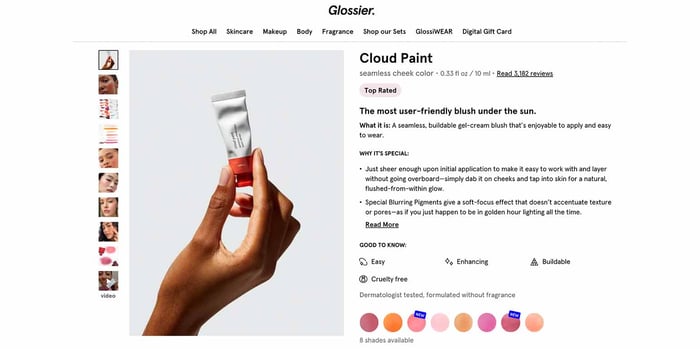
Product descriptions that break the mold
Did you think it was odd we didn’t start with images?
Yes, they’re vital in cosmetics catalogs, but when the buyer assesses and opts for a cosmetic product it is because they have read several texts: which ingredients are included, which type of person the product is best suited to, its uses, who has recommended it, etc.
As a result, an attractive bottle may influence the buyer’s decision – but only if the customer can also find all this product information first.
The basis of this is an original description, written with the type of language used by the target consumer, and which includes essential information to identify the product for internal searches and search engines like Google.
A product description for cosmetics should include:
- The product’s name, clearly and directly.
- An attractive and explanatory subtitle, like the catch phrases used by Glossier.
- The product categories to which it belongs, to facilitate filters and cataloging of products in channels like your online store.
- A long text, intended both to describe and to inspire. This is the ideal ground for your marketing team to unleash its creativity, while including the product’s most important technical details.
Remember to sprinkle keywords throughout the product page. The more targeted and accurate they are, the more customers and conversions you’ll attract to your pages.
Below, you’ll find some of the key elements that should be included in descriptions for the cosmetics sector:
- Basic terms: care, hydration, aging, beauty, application areas, UV index, pigment, tone, nutrients, properties, antioxidant, formula, shine, illuminating, therapeutic, germs, residue, imperfections, parabens.
- Common adjectives: perfect, radiant, clean, fresh, invigorating, incredible, free, rich, easy, must-have, soft, uniform, nutritional, oily, greasy, dry, shiny, antibacterial, sensitive, smooth, silky, herbal, damaged, light, irritated, anti-inflammatory, regenerating, unisex, eco-conscious, clinically tested.
Magazine-style high quality images
Now let’s talk about the importance of photographs for cosmetic products.
Without a doubt, attractive images and a magazine style will make the difference between first-rate cosmetics manufacturers and sellers and those who inspire less confidence.
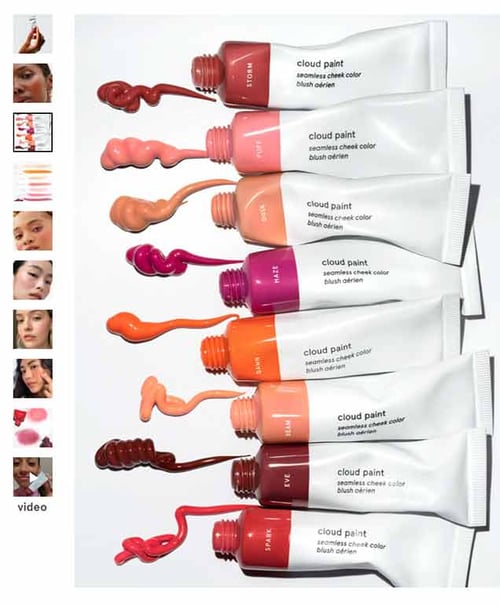
What’s more, one of the problems for the sale of cosmetics products online – particularly for makeup – is that classic customer question: “How will it suit me?” Virtual and augmented reality have begun to respond to these doubts, although it is a very expensive option to develop.
The most affordable and easy-to-develop resource within product pages are samples and visual comparisons of how the product looks on different skin colors and types. If there are variations of the same product available, such as tones for a foundation, buyers will appreciate having diverse photographic or video examples, showing how the product really looks.
Specific information: ingredients, packaging, manufacture...
Texts are a gold mine for creative content and SEO optimization in the cosmetics sector, but the buyer will also need some more technical and direct information. Sometimes, this will be the only thing they’ll look at on the product page at first glance, particularly on app versions of catalogs or brand websites.
It's more effective to highlight this type of information in list format, with bullet points, or with icons that underline key ingredients or important elements, such as the size of the container and the product’s expiration.
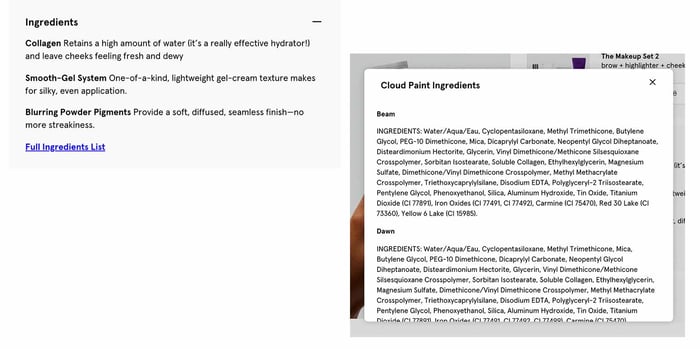
Extra product information to highlight in cosmetics sheets
In order to increase the shopping-basket value and encourage loyalty among customers who appreciate a personalized experience, it’s vital to include recommendations of products from the same range, or accompaniments.
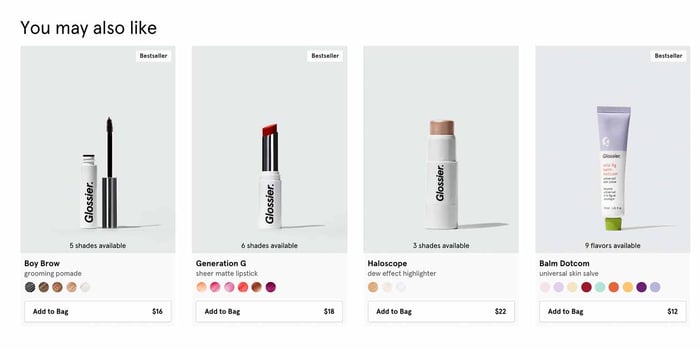
Taking a look at the example product page from Glossier, you’ll find more inspiring details to distinguish your products and offer added value to the buyer:
- A “Top-Rated” label to highlight product popularity. This captures visitors’ attention and serves as social proof for the customer that the product is backed by the public. Other similar cosmetics product labels could include “Best Seller” or “New” (as highlighted in the colors of the variations offered on this page).
- Represent color variations with textured icons that are easier to compare, without opening tables or images.
- Scientifically based pitch, attesting that the product has been dermatologically tested and letting customers know what type of formula it contains.
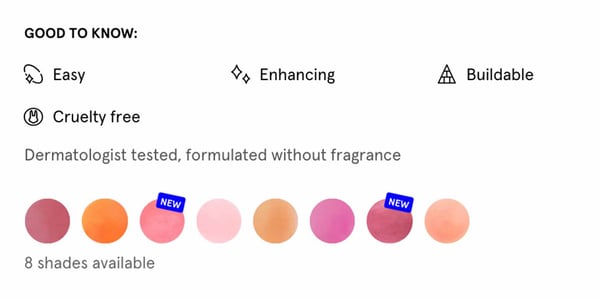
Tutorials or tips videos with experts or influencers
Video is getting stronger in 2021, and cosmetics consumers like to know that they are using products worthy of specialists in the sector... and that they can use them with the same expertise.
Offering additional and free educational information is highly valued by customers, whether through text, images and videos on the product page, or on the brand’s own YouTube channel or blog.
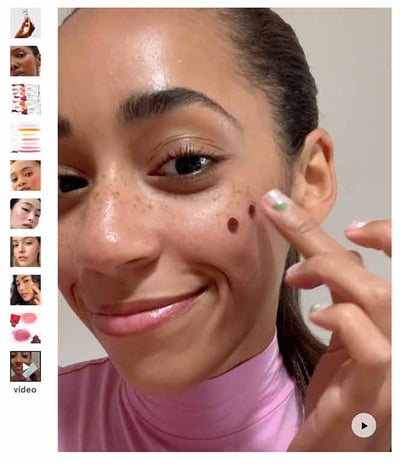
For example, the cosmetics brand Lush always shows a loop video as soon as you open its product pages, capturing users’ attention.
Filtered reviews and ratings
For products that are difficult to consult and buy online without trying them out first, the opinions of other buyers are essential for customers’ final decisions.
In cosmetics, reviews are one of the main means of conversion from product pages, so it’s important to highlight these as high as possible on each product page, and include a good number of opinions. Encouraging buyers’ participation is a vital task for any marketing team in order to obtain this content.
For example, Glossier applies this resource very effectively by highlighting three positive product reviews and, further down, offering the option to read all reviews and apply filters that facilitate personalization (to find reviews written by people of the same age or skin type like the user).

Awards and quality labels
Consumer confidence in cosmetics starts with the opinions of other users, but is also reinforced via the authority exuded by the brand or seller.
Conversions in cosmetic products will increase if your pages include the labels and guarantees that the target buyer values, such as awards and recognitions from shows, specialist organizations or sector magazines; PETA, Leaping Bunny or WWF (World Wide Fund) labels for cruelty-free products; or symbols of organic or vegan ingredients.
Finally, given the rise of BOPIS (Buy Online, Pick-Up In Store) in the last year, it has become incredibly valuable to include a store and stock locator.
Particularly for websites of cosmetics brands that only sell through retailers, this integration facilitates customer access to the catalog and avoids any loss of potential buyers that may turn to the competition or other marketplaces offering a lower profit margin.
How to organize and improve the content of your cosmetic products?
If you’re looking for new cosmetics sales techniques for 2021, dare to give your product content a makeover – without the need for any complex face lifts.
PIM tools are becoming the most frequently used software for manufacturers and retailers as a result of its agility, rapid implementation and ease of learning, for any user.
Try it for free with Sales Layer for 30 days and discover how easy it is to organize and offer all the resources and information your buyers expect.



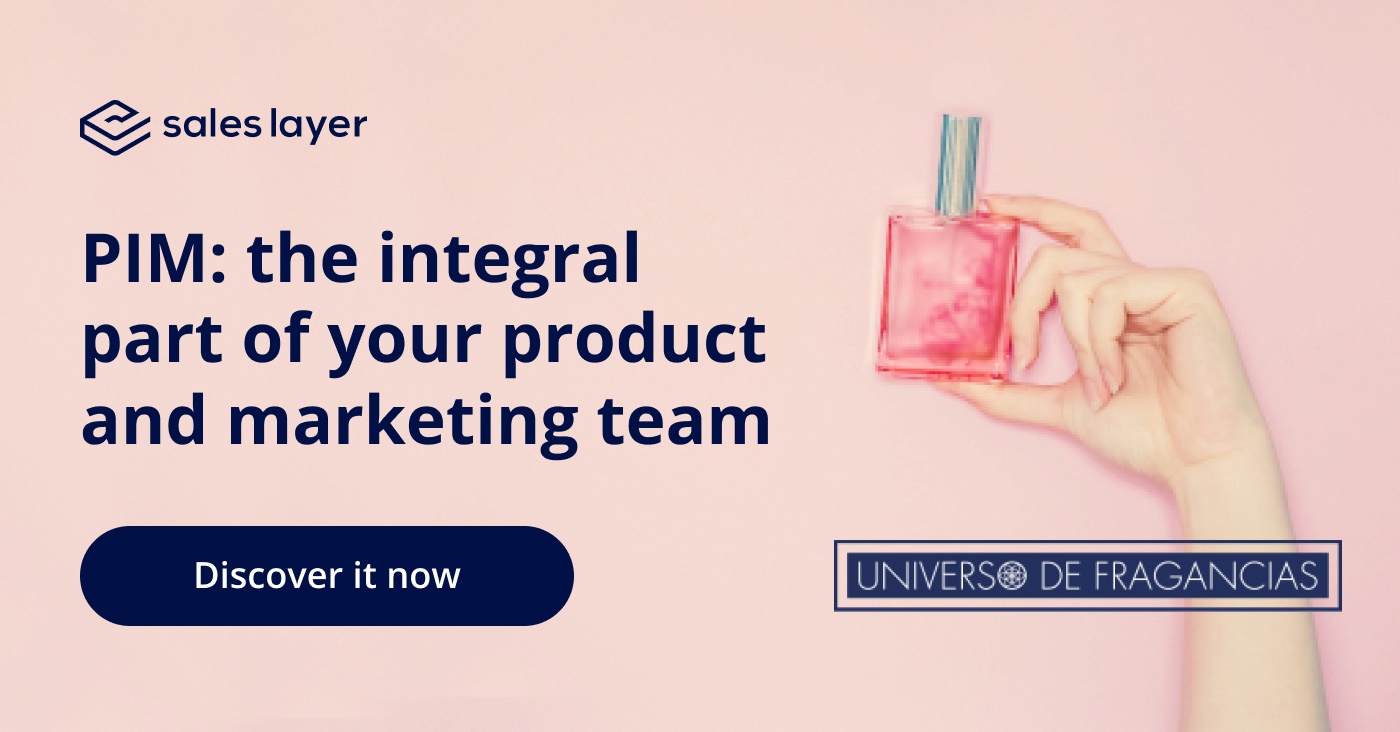
.png?width=520&name=Blog%20Partner%20(3).png)

.png?width=520&name=Blog%20Partner%20(1).png)


